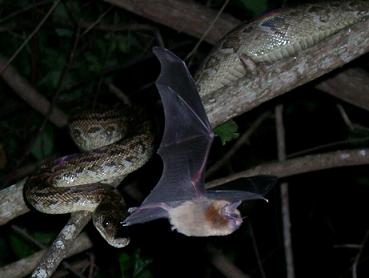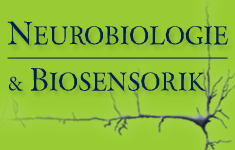|
|
||||||
|
Manfred Kössl Email:koessl@bio.uni-frankfurt.de Research projects1. Complex Sound Processing in the Gerbil Midbrain and Auditory Cortex By presenting tone complexes to the ear that will produce mechanical distortions in the cochlea, we study the neuronal computation of cochlea-generated otoacoustic emissions. One of our main aims is to investigate the role of cochlear two-tone distortions for pitch-perception. Methods: Simultaneous OAE-recording and extracellular neuronal recordings, acoustic masking techniques. Support: DFG Ko987/9-1
2. Development of Time Computation in the Auditory Cortex of Bats The postnatal development of time-sensitive neuronal circuits is investigated in the secondary auditory cortex of the bats Pteronotus parnelii and Carollia perspicillata. Specifically, we study the physiological and neuroanatomical properties of delay-sensitive neurons that use the delay between echolocation call and echo to derive the target distance during echolocation. The studies on P. parnelli are performed in Cuba. Here we have access to young mustached bats that are reared in maternity colonies in hot caves. The project is a collaboration between the Univ. of Frankfurt, the Univ. of Potsdam, and the Univ. of Havana. Methods: Extracellular recording techniques, immuno-histochemistry, acoustic deprivation techniques Support: DFG Ko987/10-1
3. Evolution of Auditory Systems in Mammals and Insects Animals adapted to different acoustic environment are investigated in terms of their ear mechanics. Methods: Noninvasive measurement of Otoacoustic Emissions (OAEs), electrophysiology, laser-interferometry, immuno-histochemistry, in-situ hybridisation, gene-sequencing, modelling. Support: DFG Ko987/8-2, Jürgen Manchot Foundation, Evangelisches Studienwerk
Publications 2013, 2012, 2011, 2010, 2009, 2008, 2007, 2006, 2005, 2004, 2003, 2002, 2001 Macías S, Hechavarría JC, Kössl M, Mora EC. Neurons in the inferior colliculus of the mustached bat are tuned both to echo-delay and sound duration. Neuroreport. 2013 Mar 12. [Epub ahead of print] PMID: 23492868 [PubMed - as supplied by publisher] Related citations Hechavarría J.C., Macías S, Vater M, Mora EC, Kössl M. Evolution of neuronal mechanisms for echolocation: specializations for target-range computation in bats of the genus Pteronotus. J Acoust Soc Am. 2013 Jan;133(1):570-8. doi: 10.1121/1.4768794. PMID: 23297928 [PubMed - in process] Macías S, Mora EC, Hechavarría J.C., Kössl M. Properties of echo delay-tuning receptive fields in the inferior colliculus of the mustached bat. Hear Res. 2012 Apr;286(1-2):1-8. doi: 10.1016/j.heares.2012.02.013. Epub 2012 Mar 15. Möckel D, Kössl M and Nowotny M (2013) Mechanical two-tone-distortions in the tympanum motion of locusts. 10th Göttingen Meeting of the German Neuroscience Society: T17-3A. Möckel D, Kössl M and Nowotny M (2013) Mechanical two-tone-distortions in the movement of the tympanal membrane of insects. 36th Midwinter Meeting of the Association for Research in Otolaryngology: 166. Möckel, D.; Lang, J.; Kössl, M. Nowotny, M. (2012). Temperature-dependence of DPOAEs in tympanal organs. J Exp Biol (in press). Kössl, M.; Voss, C.; Mora, E.C.; Macías, S.; Foeller, E.; Vater, M. (2012). Auditory cortex of newborn bats is prewired for echolocation. Nat Commun. 3:773. Macías, S.; Mora, E.C.; Hechavarría, Julio C. ;Kössl, M. (2012). Properties of echo delay-tuning receptive fields in the inferior colliculus Palghat Udayashankar A.; Kössl M.; Nowotny M.(2012). In-vivo measurements of tonotopically ordered traveling waves. PLoS One. 7(2): e31008. Publications 2011 - top Hagemann, C.; Vater, M.; Kössl, M. (2011) Comparison of properties of cortical echo delay-tuning in the short-tailed fruit bat and the mustached bat. J Comp Physiol A 197:605-613. Hummel, J.; Kössl, M.; Nowotny, M. (2011) Sound-induced tympanal membrane motion in bushcrickets and its relationship to sensory output. J Exp Biol 214:3596-3604. Möckel, D.; Seyfarth, E.A.; Kössl, M. (2011) Otoacoustic emissions in bushcricket ears: general characteristics and the influence of the neuroactive insecticide pymetrozine. J Comp Physiol A 197:193-202. Vater, M.; Kössl, M. (2011) Comparative aspects of cochlear functional organization in mammals. Hearing Research 273:89-99. Macías, S.; Mora, E.C.; Hechavarría, J.C.; Kössl, M. (2011) Duration tuning in the inferior colliculus of the mustached bat. J Neurophysiol 106:3119-3128 Hechavarría, J.C.; Cobo, A.T.; Fernández, Y.; Macías, S.; Kössl, M.; Mora, E.C. (2011) Sound evoked oscillation and paradoxical latency shift in the inferior colliculus neurons of the big fruit-eating bat, Artibeus jamaicensis. J Comp Physiol A (2011) 197:1159–1172 Bäuerle, P.; von der Behrens, W.; Kössl, M.; Gaese, B. (2011) Stimulus-specific adaptation in the gerbil primary auditory thalamus is the result of a fast frequency-specific habituation and is regulated by the corticofugal system. J Neuroscience 31(26):9708-9722. Nowotny M., Remus M., Kössl M., Gaese B. 2011.Trauma-induced tinnitus in gerbils centers around the induction frequency. In: Santi PA (ed.) Abstracts of the 34th Annual Midwinter Research Meeting., Association for Research in Otolaryngology.# 188 Hummel J., Kössl M., Nowotny M. 2011. Does the auditory nerve activity reflect the tympanal membrane motion in bushcrickets? 8th Göttingen Meeting of the German Neuroscience Society. # T17-8A. Lang J., Kössl M., Nowotny M. 2011. Temperature dependence of DPOAEs in grasshoppers. 8th Göttingen Meeting of the German Neuroscience Society. # T17-2C. Remus M., Gaese B., Kössl M., Nowotny M. 2011. Trauma-induced tinnitus in gerbils centers around the induction frequency. 8th Göttingen Meeting of the German Neuroscience Society. # T17-8C. Udajashankar A.P., Kössl M., Nowotny M. 2011. Auditory mechanics of bushcrickets in-vivo. 8th Göttingen Meeting of the German Neuroscience Society. # T17-4A. Voss C., Kössl M. (2011): Postnatal development of delay-sensitive neurons in the auditory cortex of the short-tailed fruit bat. 9th Göttingen Meeting of the German Neuroscience Society: T18-6C
Schlenther D., Voss C., Kössl M. (2011): Cubic and quadratic distortion-product otoacoustic emissions (DPOAE) in awake and anesthetized short-tailed fruit bats. 9th Göttingen Meeting of the German Neuroscience Society: T17-6A Nowotny, M., Palghat Udayashankar, A., Weber, M., Hummel, J. und Kössl, M. (2011). Sound Transduction in the Auditory System of Bushcrickets.?Mechanics of Hearing 2011, The 11th International Publications 2010 - top Behrens, W. vd; Bäuerle, P.; Kössl, M.; Gaese, B. (2010) Correlating stimulus-specific adaptation of cortical neurons and local field potentials in the awake rat. J Neuroscience 29: 13837-13849 Vater, M.; Föller, E.; Mora, E.C.; Coro, F.; Russell, I.J.; Kössl, M.(2010) Postnatal maturation of primary auditory cortex in the mustached bat, Pteronotus parnellii. J Neurophysiol, Feb 2010;doi:10.1152/jn.00517.2009 Hagemann, C.; Esser, K.H.; Kössl, M. (2010) A chronotopically organized target distance map in the auditory cortex of the Short-tailed Fruit Bat. J Neurophysiol 103: 222-333. Nowotny, M.; Hummel, J.; Weber, M.; Möckel, D.; Kössl, M.(2010): Publications 2009 - top Sensitive response to low-frequency cochlear distortion products in the auditory midbrain. Wittekindt, A. ; Gaese, B. ; Kössl, M. (2009): Wittekindt, A. ; Abel, C. ; Kössl, M. (2009): Hagemann, C. ; Esser, K.H. ; Kössl, M. (2009): Hagemann, C. ; Esser, K.H. ; Kössl, M. (2009): Kössl, M. ; Hagemann, C. ; Foeller, E. ; Mora, E. ; Macias, S. ; Vater, M. (2009): Publications 2008 - top Kössl, M. ; Möckel, D. ; Weber, M. ; Seyfarth, E.-A. (2008): Otoacoustic emissions from insect ears: evidence of active hearing? Möckel, D. ; Seyfarth, E.-A. ; Kössl, M. (2008): Eckrich, T.; Foeller, E.; Stuermer, I. W.; Gaese, B.; Kössl, M.(2008): Kössl, M.; Möckel, D.; Weber, M.; Seyfarth, E.-A. (2008): Publications 2007 - top Möckel, D. ; Seyfarth, E.-A. ; Kössl, M. (2007): The generation of DPOAEs in the locust ear is contingent upon the sensory neurons. Kössl, M. ; Coro, F ; Seyfarth, E.-A. ; Nässig, W. A. (2007): Möckel, D. ; Seyfarth, E.-A. ; Kössl, M. (2007): Möckel, D. ; Kössl, M. ; Seyfarth, E.-A. (2007): Marsch, R. ; Foeller, E. ; Rammes, G. ; Bunck, M. ; Kössl, M. ; Holsboer, F. ; Zieglgänsberger, W. ; Landgraf, R. ; Lutz, B. ; Wotjak, C. T. (2007): von der Behrens, W. ; Kössl, M. ; Gaese, B. (2007): von der Behrens, W. ; Kössl, M. ; Gaese, B. (2007): Publications 2006 - top L1,L2 maps of distortion-product otoacoustic emissions from a moth ear with only two auditory receptor neurons. Weber, M. ; Baumgarten, D. ; Winter; H. ; Kössl, M. ; Seyfarth, E.-A. (2006): Kössl, M. (2006): Möckel, D. ; Seyfarth, E.-A. ; Kössl, M. (2006): Foeller, E. ; Vater, M. ; Mora, E. ; Coro, F. ; Kössl, M. (2006): Schützner, P. ; Bäuerle, P. ; Kössl, M. (2006): Macias, S. ; Mora, E. C. ; Coro, F. ; Kössl, M. (2006): Publications 2005 - top Weber, M. ; Kössl, M. ; Volknandt, W. ; Seyfarth, E.-A. (2005): Acetylcholine is a transmitter candidate in sensory neurons of the bushcricket ear (Mecopoda elongata). Wittekindt, A. ; Drexl, M. ; Kössl, M. (2005): Isheim, D. ; Gaese, B. ; Kössl, M. (2005): Isheim, D. ; Gaese, B. ; Kössl, M. (2005): Foeller, E. ; Mora, E. ; Kössl, M. (2005): Publications 2004 - top Mora, E. C. ; Kössl, M. (2004): Ambiguities in sound-duration selectivity by neurons in the inferior colliculus of the bat Molossus molossus from Cuba. Drexl, M. ; Henke, J. ; Kössl, M. (2004): Mora, E. C. ; Macias, S. ; Vater, M. ; Coro, F. ; Kössl, M. (2004): Publications 2003 - top Vater, M. ; Kössl, M. ; Foeller, E. ; Coro, F. ; Mora, E. ; Russell, I. J. (2003): Development of echolocation calls in the mustached bat,Pteronotus parnellii. Drexl, M. ; Faulstich, M. ; von Stebut, B. ; Radtke-Schuller, S. ;Kössl, M. (2003): Kössl, M. ; Foeller, E. ; Faulstich, M. (2003): Kössl, M. ; Foeller, E. ; Drexl, M. ; Vater, M. ; Mora, E. ; Coro, F. ; Russell, I. J. (2003): Drexl, M. ; Kössl, M. (2003): Russell, I. J. ; Drexl, M. ; Foeller, E. ; Vater, M. ; Kössl, M. (2003): Russell, I. J. ; Drexl, M. ; Foeller, E. ; Vater, M. ; Kössl, M. (2003): Vater, M. ; Kössl, M. (2003): Abel, C. ; Plassmann, W. ; Kössl, M. (2003): Wittekindt, A. ; Drexl, M. ; Kössl, M. (2003): Publications 2002 - top Für ein paar Motten mehr. Pibal, I. ; Drexl, M. ; Kössl, M. (2002): Weissenbacher, P. ; Drexl, M. ; Kössl, M. (2002): Publications 2001 - top Components of the 2f(1)-f(2) distortion-product otoacoustic emission in a moth. Foeller, E. ; Vater, M. ; Kössl, M. (2001): |
FB15
Arbeitskreis Neurobiologie und Biosensorik
Institut für Zellbiologie und Neurowissenschaft
Biologicum, Campus Riedberg
Gebäudeteil A, 3. Stock
Max-von-Laue-Str. 13
60438 Frankfurt am Main
T +49 69 798-42050
E-Mail
- Studying at Goethe University
- International applicants
- Faculties
- Overview of study programmes
- Programme for refugees
- GRADE
- Goethe Business School (continuing education)
- Research at Goethe University
- Scientific news
- Goethe Welcome Center (for international researchers)
- Collaborative research projects
- Individual research
- Visiting fellowships
- Endowed chairs
- About the University
- News-in-brief
- University administration
- Campus locations
- Campus life
- University archives (German)
- Rhine-Main-Universities







